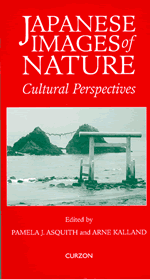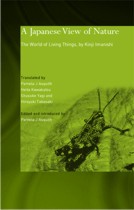Books and Monographs
A Japanese View of Nature
The World of Living Things
by Kinji Imanishi
Translated by Pamela J. Asquith, Heita Kawakatsu, Shusuke Yagi & Hiroyuki Takasaki. Edited and Introduced by Pamela J. Asquith, 2002. London, and New York: RoutledgeCurzon.
A Japanese View of Nature
Although Seibutsu no Sekai (The World of Living Things), the seminal 1941 work of Kinji Imanishi, had an enormous impact in Japan, both on scholars and on the general public, very little is known about it in the English-speaking world.
This book makes the complete text available in English for the first time and provides an extensive introduction and notes to set the work in context. Imanishi's work, based on a wide knowledge of science and the natural world, puts forward a distinctive view of nature and how it should be studied. Ecologist, anthropologist, and founder of primatology in Japan, Imanishi's first book is a philosophical biology that informs many of this later ideas on species society, species recognition, culture in the animal world, cooperation and habitat segregation in nature, the "life" of nonliving things and the relationships between organisms and their environments.
Imanishi's work is of particular interest for contemporary discussions of units and levels of selection in evolutionary biology and philosophy, and as a background to the development of some contributions to ecology, primatology and human social evolution theory in Japan. Imanishi's views are extremely interesting because he formulated an approach to viewing nature that challenged the usual international ideas of the time, and that foreshadows approaches to study of the biosphere that have currency today.
A Japanese View of Nature is the first book in a new RoutledgeCurzon series [Japan Anthropology Workshop (JAWS) series]
Asquith, P.J. 2000, Japanese Scholarship and International Academic Discourse. Guest edited issue of Ritsumeikan Journal of Asia Pacific Studies, vol. 6 (December)


Asquith, P.J. and A. Kalland (eds.) (1997) Japanese Images of Nature: Cultural Perspectives. London: Curzon Press. 290 pp. [refereed]
It is often claimed that the Japanese have a particular love for nature, a love cornmonly reflected in their art and material culture. But today equal notice is being paid to the environmental degradation caused by the Japanese at home as well as abroad. How can these phenomena be reconciled? This issue is but one of several addressed in this examination of the human-nature relationship in Japan. Through topics ranging from medieval poetry and fine arts to vending machines and tourism, the authors document the great diversity in how people perceive their natural environment and how they come to terms with nature, be it through brute force, rituals or idealization. The main message of the book is that "culture" and the "natural" are concepts very much condititioned by their context, an approach quite different from the uncompromising stance so often found in the West.
Fedigan, L.M. and P.J. Asquith (eds.) 1991. The Monkeys of Arashiyama: Thirty-five Years of Research in Japan and the West. New York: SUNY. 353 pp. [refereed]
In The Monkeys of Arashiyama: Thirty-five Years of Research in Japan and the West, Linda Fedigan and Pamela Asquith reveal the diversity of research on the Arashiyama Japanese macaques, and the Japanese and Western traditions in primate studies. The essays reflect studies by primatologists with the populations at Arashiyama, Kyoto, and the subgroup which fissioned from the original and was transferred to Texas in 1972.

Akimichi, T., P.J. Asquith, H. Befu, T. Bestor, S.R. Braund, M.M.R. Freeman, H. Hardacre, M.Iwasaki, A. Kalland, L.Manderson, B.D.Moeran, J. Takahashi. 1988. Small- Type Coastal Whaling in Japan. Boreal Instit. for Northern Studies. 116 pp. Translated into Japanese (1989) Kujira no Bunkajinruigaku (Anthropology of the Whale). Tokyo: Kaimeisha.
Selected Articles and Chapters in Books:Asquith, P.J. 2000. The Right to Differ, but How to be Understood? Challenges to Presenting and Critiquing Japanese Disciplinary Perspectives. Ritsumeikan Journal of Asia Pacific Studies, vol. 6: 50-57.
Asquith, P.J. 2000. Negotiating science: Internationalization and Japanese
primatology. In S. Strum and L.M. Fedigan (eds.) Primate Encounters: Models of Science, Gender, and Society. Chicago, Ill.: The University of Chicago Press:165-183.Asquith, P.J. 1999. The ‘world system’ of anthropology and ‘professional others’. In E.L. Cerroni-Long (ed.) Anthropological Theory in North America. Westport, CT: Greenwood Publ.: 31-49.
Asquith, P.J. 1997. Why anthropomorphism is not metaphor: Crossing concepts and cultures in animal behavior studies. In R. W. Mitchell, N. S. Thompson, and H. Lyn Miles (eds.) Anthropomorphism, Anecdotes, and Animals: The Emperor's New Clothes? New York: SUNY: 22-34.
Kalland, A. & P.J. Asquith. 1997. Japanese Perceptions of Nature: Ideals and Illusions. In P.J. Asquith and A. Kalland (eds.) Japanese Images of Nature: Cultural Perspectives. London: Curzon:1-35.
Asquith, P.J. 1996. Japanese science and Western hegemonies: Primatology and the limits set to questions. In L. Nader (ed.) Naked Science: Anthropological Inquiry into Boundaries, Power and Knowledge. New York: Routledge: 239-256.
Asquith, P.J. 1995. Of monkeys and men: Cultural views in Japan and the West. In Robert Corbey and Burt Theunissen (eds.) Ape, Man, Apeman: Changing Views, 1600-2000. Leiden: Royal Netherlands Academy of Arts and Sciences, pp. 308-325.
Asquith, P.J., 1994. The intellectual history of field studies in primatology, East and West. In L.K. Chan and A. Herring (eds.) Strength in Diversity: A Reader in Physical Anthropology, Toronto: Canadian Scholars' Press, pp. 49-75.
Asquith, P.J., 1994. Cultural and international influences on Japanese science and technology. In T. Tsushima (ed.) The Global Role of Modern Japan: Proc. of the Japan Studies Association of Canada. Edmonton, pp. 1-9.
Asquith, P.J., 1992. Imanishi Kinji and Japanese Ecology. Trends in Ecology and Evolution., Vol. 7, No. 9: 285-286.
Fedigan, L.M., P.J. Asquith, 1992. Arashiyama research as a microcosm of larger trends in Primatology. Topics in Primatology. Vol. 2, Eds. N. Itoigawa et al. University of Tokyo Press: 67-77.
Asquith, P.J., 1990. The Japanese idea of soul in animals and objects as evidenced by kuyo services. In Discovering Japan: Issues for Canadians. Eds. D.J. Daly & T.T. Sekine. Toronto: Captus Press: 181-188.
Asquith, P.J., 1989. Provisioning and the study of free-ranging primates: History, effects and prospects. Yearbook of Physical Anthropology (32):129-158.
Asquith, P.J., 1986. Imanishi's impact in Japan. Nature 323:675-676. Reprinted in 1988: Imanishi Shinkaron Hihan no Tabi (Journal of a Critique of Imanishi's Evolution Theory) Transl. of B. Halstead's "Kinji Imanishi: The View from the Mountaintop", by A. Nakayama. Tokyo: Tsukiji Shokan: 257-260.
Asquith, P.J., 1986. Anthropomorphism and the Japanese and Western traditions in primatology. Primate Ontogeny, Cognition and Social Behavior Eds. J.G. Else & P.C. Lee. Cambridge University Press: 61-71.
Asquith, P.J., 1986. The monkey memorial service of Japanese primatologists. In T. sugiyama Lebra & W.P. Lebra (eds.) Japanese Culture and Behaviour: Selected Readings. University of Hawai'i Press: 29-32.
Asquith, P.J., 1984. The inevitability and utility of anthropomorphism in description of primate behaviour. The Meaning of Primate Signals Eds. R. Harré & V. Reynolds. Cambridge University Press: 138-176.
Asquith, P.J., 1984. Reichôruigaku no hôkô (Directions in Primatology). Shiso (717):3:36-51 (In Japanese). Reprinted in 1989: Imanishi Kinji: Sono Hito to Shisô (Imanishi Kinji: The Man and His Thought). Ed. J. Kawakita. Tokyo: Perikansha: 380-402.
